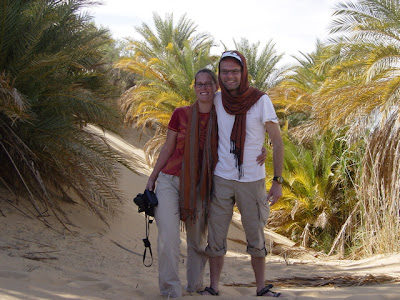Tuesday, April 10, 2007
Day 5: Abu Simbel
Kasr Ibrim meets Kasr Ibrim
Kasr Ibrim (Ibrim’s fortress in Arabic) is the only Nubian structure that is still in its original location. Although the waters of Lake Nasser did not reach its location on a 70m high cliff, it is very close and masks the original strategic location. The condition of the mud brick walls is so poor that we were not allowed to get off the boat and walk around there, but Kasr Ibrim the ship did sail very close to Kasr Ibrim the fortress for us to have a look. Apart from the structure that is still visible many written documents were found here.
After this short stop we continued our journey to Abu Simbel. On our way he had a view of the water inlet for the New Valley irrigation project at Toshka on the west bank. This project is heralded by the Egyptian government to provide water and agricultural land for future generations. Currently, it has not proved to be working (yet?).
Towards midday we started seeing the contours of the magnificent temple of Ramses II at Abu Simbel. As we got closer also the smaller temple of Nefertari started to become visible. We were very happy with our new camera with 200mm zoom lens to see this from such a large distance. We had lunch on board next to the temple and in the afternoon when the crowds that arrived by the bus and planeloads had left we went for our excursion.
Abu Simbel
We walked around the artificial hill that hosts the temples since their move in the 60s to arrive in front of the temple that Ramses II build for his favourite wife Nefertari. At first sight this looks like a very altruistic project of megalomaniac Ramses II. He even build the 10m high statues of Nefertari, in front of the temple, at the same height as his own statues, and not like most temples only at knee height of his own statue. However, Ramses being Ramses, made sure that the temple dedicated to his wife is fronted with four of his own statues and only two of Nefertari.
The temple is hewn out of a cliff face and is dedicated to Goddess Hathor. In the hypostyle hall there are six pillars crowned with Hathor capitals and the walls show beautiful reliefs of Nefertari before Hathor and Mut. Some of these reliefs depict Ramses fighting gloriously with Nefertari and Hathor in the background supporting him.
Unfortunately, after many tourist violating the “no flash” signs (flashlight damages the paint), it is now forbidden altogether to make photographs inside the temples.
If you thought the Nefertari temple had big statues, the Ramses II temple has four (actually three and a half) ginormous statues. These sitting statues are 20m high and these were cut in to 30 ton (!) pieces when moved during the UNESCO project in the 60s. One statue was already broken into pieces during an earthquake in ancient times. We could not see any sign of the rock cuts of the move. The statues were half covered in sand when this temple was first rediscovered in 1813. You can still see the 19th century graffiti high on the statues. The faces of the statues seem to look through time and must have been very impressive when foreigners entered the pharaonic land along the Nile from the south (actually they still are).
On the walls of the base of these four massive statues, Libyan, Syrian and Nubian prisoners of war, trophies of Ramses’ wars, are depicted. You can see nicely the foreign features of these captives.
Inside the hypostyle hall with eight columns fronted by Ramses statues, the walls show the battle of Kadesh in Syria, in such detail that it is like reading a film script. The scenes show a fortified Hittite town surrounded by the Orontes River and the Egyptian army camp. Another wall shows Ramses trampling his enemies.
We looked at all the details of these scenes and we were lucky that we were with just the two of us in this world-class cultural heritage site. Very special considering how busy it usually is here.
In the inner sanctuary, there are statues of Amon-Ra, Ra-Harakhty, Ptah and Ramses II. Two times a year, on 22 February and on 22 October, the morning sun shines its light exactly though the column corridor onto all statues except Ptah.
That evening we had a candlelight dinner on the outside deck of the Kasr Ibrim, with views on the lit temples.
11 April
We left the Kasr Ibrim at 0545 AM to see the sunrise on the Abu Simbel temples. The warm morning light made the colour of the temples look golden. We were lucky to be there just before the crowds arrived.
Subscribe to:
Post Comments (Atom)












No comments:
Post a Comment